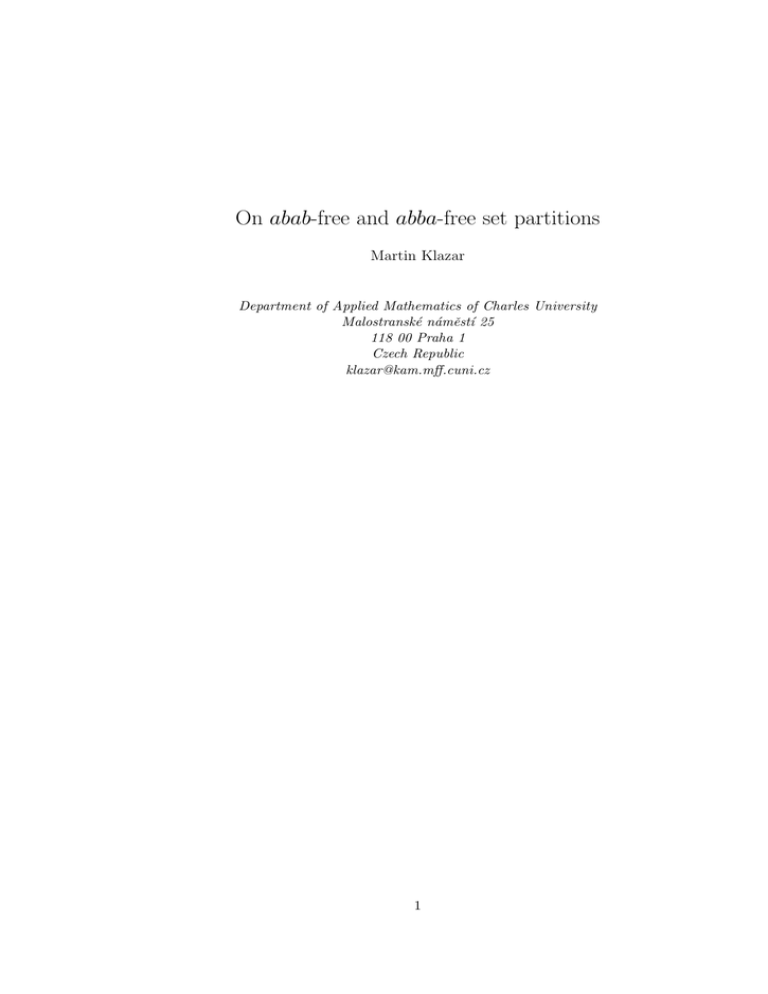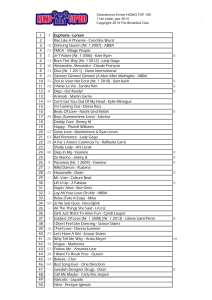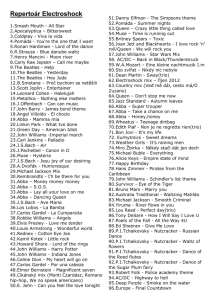On abab-free and abba-free set partitions
advertisement

On abab-free and abba-free set partitions
Martin Klazar
Department of Applied Mathematics of Charles University
Malostranské náměstı́ 25
118 00 Praha 1
Czech Republic
klazar@kam.mff.cuni.cz
1
2
Set partitions
Martin Klazar
Department of Applied Mathematics of Charles University
Malostranské náměstı́ 25
118 00 Praha 1
Czech Republic
klazar@kam.mff.cuni.cz
3
Abstract
These are partitions of [l] = {1, 2, . . . , l} into n blocks such that no four term subsequence of [l] induces
the mentioned pattern and each k consecutive numbers of [l] fall into different blocks. These structures
are motivated by Davenport-Schinzel sequences. We summarize and extend known enumerative results
for the pattern p = abab and give an explicit formula for the number p(abab, n, l, k) of such partitions. Our
main tool are generating functions. We determine the corresponding generating function for p = abba
and k = 1, 2, 3. For k = 2 there is a connection with the number of directed animals. We solve exactly
two related extremal problems.
4
1
Introduction and notation
A partition P of [l] = {1, 2, . . . , l} is a collection (B1 , B2 , . . . , Bn ) of nonempty disjoint subsets of [l],
called blocks, whose union is [l] and which are listed in the increasing order of their least elements.
We define |P | = l and kP k = n. Empty partition is denoted by ∅. Any partition P can be written
in the canonical sequential form P = a1 a2 . . . al where i ∈ Bai . One can use any set of n symbols
to express P this way. We call it sequential form and we call the set of symbols alphabet of P . For
instance, 123242151 is the canonical sequential form of P0 = ({1, 7, 9}, {2, 4, 6}, {3}, {5}, {8}). One of
possible sequential forms is ctrtdtcwc, the alphabet is {c, t, r, d, w}. We are interested in enumeration of
pattern-free partitions and therefore we will use often the sequential form.
A partition P is k-regular , k ≥ 1, if x, y ∈ Bi , x > y, implies x − y ≥ k. In other words, each k or
less consecutive elements in the sequence are mutually different. The partition P0 is not 3-regular but
is 2-regular. 1-regularity poses no restriction. We say that P is abab-free if x, y ∈ Bi and z, t ∈ Bj for
no four numbers x < z < y < t and two different blocks Bi , Bj . Similarly, P is abba-free if x, y ∈ Bi
and z, t ∈ Bj for no four numbers x < z < t < y and two different blocks. In other words, no four term
subsequence of the type abab, resp. abba, is present. It is easy to check that P0 above is abab-free but
not abba-free.
Suppose p = abab or p = abba. By p(p, n, l, k) we denote the cardinality of the set P(p, n, l, k) of
k-regular and p-free partitions of [l] with n blocks. P (p, k) stands for the bivariate generating function
X
P (p, k) = P (p, k)(x, y) =
p(p, n, l, k)xn y l .
n,l≥0
P
S
By p(p, n, ·, k), resp. P(p, n, ·, k), we mean l≥0 p(p, n, l, k), resp.
l≥0 P(p, n, l, k). Similarly for n
replaced by the dot. Obviously p(p, n, ·, 1) = ∞ but it is not difficult to see that p(p, n, ·, k) < ∞ for
k ≥ 2. We define, for k ≥ 2 and n ≥ 0, Ex(p, n, k) to be the maximum l such that P(p, n, l, k) is
nonempty.
The sets P(abab, n, l, 1) appeared first in Kreweras [11] under the name of noncrossing partitions. The
sets P(abab, n, ·, 2) were introduced by Davenport and Schinzel [3] when they studied Ex(abab, n, 2) as a
special case of a more general extremal function. The function Ex(abab, n, 2) is often denoted as λ2 (n)
and is a special case of maximum lengths of Davenport-Schinzel sequences (we determine Ex(abab, n, k)
in Theorem 2.2). What is λ3 (n) then? Ex(ababa, n, 2), this function is far more difficult to handle. See
[7], [15], [1], and [8] for more information and referrences.
The next section contains strenghtenings and generalizations of several known enumerative results
concerning P(abab, ·, ·, ·). We determine the generating function P (abab, k) and use it to generalize in
Theorem 2.5 an identity of Simion and Ullman and to derive a general explicit formula for p(abab, n, l, k).
Nice formulas for these numbers are summarized in Theorem 2.7. Various specializations lead to Catalan,
Motzkin, Narayana, and Schröder numbers. In the third section we determine in Theorem 3.1 the
function Ex(abba, n, k) and in Theorem 3.5 we derive an identity for P (abba, k). Then we proceed to
determine P (abba, k) for k = 1, 2, 3. A specialization leads to numbers of directed animals with one root.
In the last section we pose several problems.
2
abab-free partitions
The set of k-regular partitions of length < k − 1 is simply C(k) = {∅, x1 , x1 x2 , . . . , x1 x2 . . . xk−2 }. The
symbol X j means the cartesian product X × X × . . . × X j times. Here A × ∅ = A. Consider the
mapping
[
F :
(P(abab, ·, ·, k)\C(k))j−1 × P(abab, ·, ·, k) → P(abab, ·, ·, k)\{∅}
j≥1
5
defined by F (u1 , u2 , . . . , uj ) = xu1 xu2 x . . . xuj where the partitions ui are interpreted as sequences with
disjoint alphabets and x is a completely new symbol. The following easy lemma is crucial for handling
abab-free partitions.
P
P
Lemma 2.1 F is a bijection and if F (u1 , u2 , . . . , uj ) = u then
kui k = kuk − 1 and
|ui | = |u| − j.
Proof. It is easy to see that F is defined correctly and preserves lengths and numbers of blocks in
the stated manner. Take a u ∈ P(abab, ·, ·, k), u 6= ∅, and consider the unique decomposition u =
xu1 xu2 x . . . xuj given by the occurrences of the first symbol. Note that the alphabets of ui s are disjoint.
Obviously F (u1 , u2 , . . . , uj ) = u and we see that F is bijective.
2
The following theorem generalizes the result Ex(abab, n, 2) = 2n − 1 of Davenport and Schinzel [3].
Theorem 2.2 Suppose k ≥ 2. For 0 ≤ n ≤ k − 1 we have Ex(abab, n, k) = n. For n ≥ k − 1 we have
Ex(abab, n, k) = 2n − k + 1 and, for k ≥ 3, only one partition realizing this length:
u(n, k) = a1 a2 . . . an−k+1 b1 b2 . . . bk−1 an−k+1 an−k . . . a2 a1 .
Proof. The first equality is trivial. We prove the rest by induction on n. For n = k − 1 it is true.
We show first Ex(abab, n, k) ≤ 2n − k + 1. Suppose n > k − 1 and take a u ∈ P(abab, n, ·, k). If no
symbol in u repeats we are done. Otherwise consider the shortest interval I in u starting and ending
with the same symbol. Clearly |I| ≥ k + 1 and, except for the end elements, no symbol in I repeats.
The inner symbols of I cannot apppear elsewhere. Deleting the first two elements of I we get a partition
v in P(abab, n − 1, ·, k). So |u| = |v| + 2 ≤ 2n − 2 − k + 1 + 2 = 2n − k + 1 and we conclude that
Ex(abab, n, k) = 2n − k + 1.
Now suppose, in addition, that u attains the maximum length. Consider the decomposition u =
xu1 xu2 x . . . xuj of Lemma 2.1. j = 1 is impossible for then x could be added to the end of u. So j ≥ 2.
If uj is nonempty and has no repetition then it can be added before u in the opposite order. If uj is
nonempty and has a repetition then x again can be added to the end of u. So uj is empty. If j > 2
Pj−1
Pj−1
we get a contradiction |u| = i=1 |xui | + 1 ≤ i=1 (2kxui k − k) + 1 = 2n + 2(j − 2) − (j − 1)k + 1 =
2n − (j − 1)(k − 2) − 1 < 2n − k + 1. So j = 2 and u2 = ∅. Applying the induction assumption on u1
we conclude that u = u(n, k).
2
For k = 2 the longest partition is not unique, actually p(abab, n, 2n − 1, 2) = 2n−2
n−1 /n. This was proved
first by Mullin and Stanton [12]. The following is both generalization and simplification of the argument
of Gardy and Gouyou-Beauchamps [5] (k = 2).
Theorem 2.3 For any k ≥ 1,
P (abab, k)(x, y) =
p
1 1 + y + yC(k) − xy − (1 + y + yC(k) − xy)2 − 4y(1 + yC(k))
2y
where C(k) = C(k)(x, y) = 1 + xy + (xy)2 + . . . + (xy)k−2 (C(2) = 1, C(1) = 0) is the generating function
for C(k).
Proof. Lemma 2.1 translates directly to generating functions:
P (abab, k) = 1 + x
X
j≥1
y j (P (abab, k) − C(k))j−1 P (abab, k) = 1 +
xyP (abab, k)
.
1 + yC(k) − yP (abab, k)
Thus we have the quadratic equation yP (abab, k)2 − (1 + y + yC(k) − xy)P (abab, k) + 1 + yC(k) = 0.
Taking P (abab, k)(0, 0) = 1 into account we get the above solution.
2
6
Some specializations of P (abab, k)(x, y) generate standard sequences of numbers. Several special cases
of P (abab,
were also investigated before. Setting k = 1 and x = 1 we get the generating function
√ k)(x, y)
1
1
−
1
−
4y
of the sequence {p(abab, ·, l, 1)}l≥1 = {1, 2, 5, 14, 42, 132, 429, . . .} of notorious Catalan
2y
√
numbers, A0108 in [E]. For k = 2 and y = 1 we get the generating function 12 3 − x − 1 − 6x + x2
of {p(abab, n, ·, 2)}n≥1 = {1, 2, 6, 22, 90, 394, 1806, . . .}. These are twice the Schröder numbers, A1003 in
[E], which appeared first in [14]. The generating
(P (abab, 2)(x,
function
1) − 1 + x)/2 was derived in [12].
p
1
2
The specialization k = 2 and x = 1 yields 2y 1 + y − 1 − 2y − 3y generating {p(abab, ·, l, 2)}l≥1 =
{1, 1, 2, 4, 9, 21, 51, . . .} which are Motzkin numbers, A1006 in [E], see [4]. For k ≥ 4 the sequences
{p(abab, n, ·, k)}n≥1 seem new, for instance {p(abab, n, ·, 4)}n≥3 = {1, 2, 5, 13, 35, 97, 275, . . .}. For k = 3
we get Catalan number once again. {p(abab, ·, l, k)}l≥1 for k ≥ 3 are not new, {p(abab, ·, l, 3)}l≥3 =
{1, 2, 4, 8, 17, 37, 82, . . .} is the sequence A4148 in [E]. These sequences were investigated in [17] by Stein
and Waterman who, motivated by the secondary structure of the molecules of nucleic acids, introduced
there the sets P(abab, ·, l, k). They mentioned without proof the result of C. J. Everett which we restate
as the second half of the following theorem. We omit the proof as well.
Theorem 2.4
1/n
lim lim p(abab, n, ·, k)
k→∞ n→∞
√
3+ 5
=
and
2
lim lim p(abab, ·, l, k)1/l = 2.
k→∞ l→∞
The following theorem refines the identity of [16] where the version with two parameters k and l can be
found (the proof there is combinatorial).
Theorem 2.5 For any n, l ≥ 1, k ≥ 2, it is true that p(abab, n, l, k) = p≤2 (abab, n − 1, l − 1, k − 1).
The subscript ≤ 2 means that we consider only the partitions with all blocks of size at most 2. Briefly,
xyP≤2 (abab, k − 1) = P (abab, k) − 1.
Proof. The generating function P≤2 (abab, k)(x, y) is defined in the obvious manner. The relation
for it differs from the one for P (abab, k) only in that j may now attain only the values 1 and 2. So
P≤2 (abab, k) = 1 + x(yP≤2 (abab, k) + y 2 (P≤2 (abab, k) − C(k))P≤2 (abab, k)) and we get the equation
y(xyP≤2 (abab, k))2 − (1 + xy 2 C(k) − xy)(xyP≤2 (abab, k)) + xy = 0. Thus
xyP≤2 (abab, k − 1)(x, y) =
p
1 1 + xy 2 C(k − 1) − xy − (1 + xy 2 C(k − 1) − xy)2 − 4xy 2 .
2y
Taking xy 2 C(k − 1) = yC(k) − y into account and comparing with the expression in Theorem 2.3 we
get xyP≤2 (abab, k − 1) = P (abab, k) − 1. The identity is verified.
2
Example
P(abab, ·, 5, 2) = {12345, 12343, 12342, 12341, 12324, 12321, 12314, 12134, 12131}
and
P≤2 (abab, ·, 4, 1) = {1122, 1123, 1223, 1233, 1234, 1221, 1231, 1232, 1213}.
To give an explicit formula for p(abab, n, l, k) we need first to recall a well known bijection. It matches
the elements of the sets P=2 (abab, n, 2n, 1) and T (n + 1). Here = 2 indicates partitions with all blocks
of size 2 and T (n) is the set of all rooted plane trees with n vertices. Recursively: one vertex tree
corresponds to ∅ and a general T corresponds to x1 u1 x1 x2 u2 x2 . . . xj uj xj where ui corresponds to the
ith (counted from left) principal subtree of T and j is the degree of the root of T . The sequences ui
have disjoint alphabets and the symbols xi are new and mutually different.
7
Recall that |T (n + 1)| = cn =
2n
n
/(n + 1) is the nth Catalan number. Recall the formula
1
1
a−1 a−2
a−1 a−1
n(a, b) = n(a, a − b) =
=
a−b
b
b−1
a−1
b
b−1
of Narayana [13] for the number of rooted plane trees with a vertices and b leaves.
Theorem 2.6 For k ≥ 2 and n ≤ l ≤ max(2n − k + 1, n) we have
p(abab, n, l, k) =
∗
X
b=1
l − n l − n − 1 l − 1 − b(k − 2)
1
l−n+1−b
b
b−1
2l − 2n
where ∗ = min(l − n, b 2n−l−1
k−2 c) and the empty sum is equal to 1.
Proof. By Theorem 2.5 it is enough to count the number p≤2 (abab, n − 1, l − 1, k − 1) of partitions
u ∈ P≤2 (abab, n − 1, l − 1, k − 1). Each such u has s = 2n − l − 1 singletons, symbols with one occurrence,
and d = l − n doubletons with two occurrences. The doubleton part of u corresponds, by the bijection,
to a tree T ∈ T (d + 1). By the k − 1-regularity inside of each doubleton of u corresponding to a leaf of
T there are at least k − 2 singletons, in particular b ≤ (2n − l − 1)/(k − 2) for the number b of leaves of
T . Besides this requirement singletons may be located arbitrarily in the 2d + 1 gaps of the doubleton
part. The number of such u is therefore
∗
X
2d + 1 + s − b(k − 2) − 1
n(d + 1, b)
.
s − b(k − 2)
b=1
2
This is the general formula.
In several instances one can give closed formulas.
Theorem 2.7 For n, l ≥ 1,
1
l
l−1
p(abab, n, l, 1) = n(l + 1, n) =
,
l−n+1 n n−1
l−1
1
2l − 2n
l−1
p(abab, n, l, 2) = cl−n
=
,
2l − 2n
l−n+1 l−n
2l − 2n
1
n−1
n−2
p(abab, n, l, 3) = n(n, l − n + 1) =
.
l − n + 1 2n − l − 1 2n − l − 2
Thus p(abab, n, l, 1) = p(abab, l − n + 1, l, 1), p(abab, n, l, 3) = p(abab, n, 3n − 2 − l, 3), p(abab, n, l, 3) =
p(abab, l − n + 1, n − 1, 1), and
1 2n − 2
p(abab, ·, n − 1, 1) = p(abab, n, 2n − 1, 2) = p(abab, n, ·, 3) = cn−1 =
.
n n−1
Proof. The generating function for Narayana numbers n(a, b) is
p
X
1 − x + xy − (1 − x + xy)2 − 4xy
a b
N (x, y) =
n(a, b)x y =
2
a,b≥1
where we put n(1, 1) = 1. This formula can be easily derived by considerations similar to those in the
proof of Theorem 2.3 and is well known. Consider the first three formulas. The formulas for k = 1 and
k = 3 are consequences of the identities P (abab, 1)(x, y) = N (y, x)/y − x + 1 and P (abab, 3)(x, y) =
8
N (xy, y)/y + 1 which can be readily checked. The formula for k = 2 is a special case of Theorem 2.6
since for k = 2
d
∗
X
l−1
2d + 1 + s − 1
l−1 X
n(d + 1, b) =
.cd .
n(d + 1, b)
=
2l − 2n
s
s
b=1
b=1
The remaining formulas follow from the symetry n(a, b) = n(a, a − b) and from
P
b
n(a, b) = ca−1 .
2
The formula for p(abab, n, l, 1) is contained implicitly already in the Narayana’s result since one can
prove it by an easy bijection matching partitions with trees. The formula for p(abab, n, l, 2) was derived
in [5] directly extracting the coefficient from P (abab, 2). Although our counting relies on generating
functions too, it indicates a bijective proof which is worked out in [9]. We have not seen the formula for
p(abab, n, l, 3) before.
The closed formulas for k = 2, 3 are indicated by the presence of only small prime factors in the
numbers p(abab, n, l, k) when calculated by the general formula of Theorem 2.6. For k ≥ 4 we get
typicly factorizations as p(abab, 20, 26, 4) = 2.13.330641 or p(abab, 20, 30, 5) = 5.31.2003 which seems to
exclude simple closed forms.
A sequence of numbers is called unimodal if it can be split into two parts, the initial one nondecreasing and the final one nonincreasing. The sequences {p(abab, n, l, 1)}ln=1 and {p(abab, n, l, 3)}2n−2
l=n
are unimodal and symmetric. Examining the ratio p(abab, n, l, 2)/p(abab, n, l + 1, 2) onep
can prove √
easily
1 − 1/n/ 2)c.
that {p(abab, n, l, 2)}2n−1
l=n is also unimodal and attains its maximum for l = bn(1 +
Similarly, {p(abab, n, l, k)}ln=∗ , ∗ = d(l + k − 1)/2e, k = 2, 3, are unimodal for any l ≥ 2.
Conjecture 2.8 We conjecture that the sequences {p(abab, n, l, k)}2n−k+1
and {p(abab, n, l, k)}ln=∗ are
l=n
unimodal for any n, l ≥ k − 1 and k ≥ 2.
3
abba-free partitions
Theorem 3.1 Let k ≥ 2. For 1 ≤ n ≤ k − 1 again Ex(abba, n, k) = n. For n ≥ k we have
Ex(abba, n, k) = 2n + b n−1
k−1 c − 1. The longest partition is unique iff n − 1 is divisible by k − 1. In
particular Ex(abba, n, 2) = 3n − 2 and the longest partition
1212323434545 . . . (n − 1)n(n − 1)n
is unique for any n ≥ 1.
Proof. We prove first by induction on n the general upper bound. It is true for n = k giving the value
2k. Let v ∈ P(abba, n, ·, k) and n > k.
Claim 1 One can suppose that no symbol appears in v more than three times.
In the contrary case take four occurrences of a symbol a and consider the second and the third of them.
A symbol b 6= a must appear between them and b may have only one occurrence in v, for otherwise
v is not abba-free. We delete the b-appearance plus possibly one a-appearance, the k-regularity is not
n−1
violated. By induction |v| ≤ 2(n − 1) + b n−2
k−1 c − 1 + 2 ≤ 2n + b k−1 c − 1 and we are done in this case.
Let S2 be the set of the symbols which appear in v at most twice and let S3 consist of those appearing
exactly three times. Let |S2 | = n2 and |S3 | = n3 . Thus n = n2 + n3 .
Claim 2 n3 (2k − 4) + 2 ≤ 2n2 − 2(k − 1)
By a 3-interval we mean an interval I in v which begins and ends with an a-occurrence and which has
one a-occurrence inside. There are n3 3-intervals, one for each a ∈ S3 , no two of them are comparable
by inclusion and no three of them intersect.
For any 3-interval I corresponding to an a ∈ S3 there are at least 2k −2 distinct symbols appearing in
I which are distinct to a. Only at most 2 of those symbols can belong to S3 and hence any I contributes
9
by at least 2k − 4 elements to S2 . On the other hand any x ∈ S2 can appear only in at most two
3-intervals. This gives roughly the inequality in Claim 2, the corrections +2 and −2(k − 1) are caused
by the first and by the last 3-interval — each contributes by at least 2k − 3 elements to S2 and for each
there are at least k − 1 elements of S2 which appear only in it.
Therefore n2 ≥ n3 (k − 2) + k = (n − n2 )(k − 2) + k and n2 ≥ n − n−1
k−1 + 1. Finally,
|v| ≤ 3n3 + 2n2 = 3n − n2 ≤ 2n +
n−1
− 1.
k−1
To prove that this cannot be improved we express n ≥ k in the form n − 1 = m(k − 1) + i, 0 ≤ i <
k − 1, and we consider the sequence (partition) v(n, k) = B1 B2 . . . Bm−1 Bm where the jth segment Bj ,
1 ≤ j ≤ m − 1, is of the form
Bj = j xj1 xj2 . . . xjk−2 (j + 1)j xj1 xj2 . . . xjk−2
and the mth segment is of the form
m
m
m
Bm = m xm
1 . . . xk−2 (m + 1)m y1 y2 . . . yi x1 . . . xk−2 (m + 1)y1 y2 . . . yi .
The n element alphabet here is
{1, 2, . . . , m + 1, y1 , y2 , . . . , yi } ∪ {xpq | p = 1 . . . m, q = 1 . . . k − 2}.
An easy check reveals that the k-regular v(n, k) is abba-free and that the length of v is
m(2k − 1) + 2i + 1 = 2(n − 1) + m + 1 = 2n + b
n−1
c − 1.
k−1
Thus Ex(abba, n, k) = 2n + b n−1
k−1 c − 1. If i > 0 then the symbols y1 , . . . , yi can be placed in v(n, k)
differently than it is indicated above and we get several longest partitions.
It remains to prove that for n − 1 divisible by k − 1 there is no other longest partition than v(n, k).
For n = k this is true. Let n − 1 > k − 1 be divisible by k − 1 and let u ∈ P(abba, n, ·, k) be of
the maximum length and in the canonical form. Since the length is maximum we have only symbols
appearing two times or three times and no singletons. The sequence u starts with u = 12 . . . k . . . and
each of the symbols 1, 2, . . . , k − 1 appears in u only twice, in the contrary case we would have singletons.
Thus u = 12 . . . k − 1 k . . . 1 . . . 2 . . .. The second 1 must follow immediately after k, in the contrary case
we could delete 1’s without violating k-regularity and get a sequence longer than Ex(abba, n − 1, k).
The case u = 12 . . . k1x . . . 2 . . . reduces by the switching u = 12 . . . kx1 . . . 2 . . . to the previous case. So
u = 123 . . . k123 . . . k . . .. Now k must appear three times for otherwise by deleting the initial segment
of length 2k we would decrese n by k but l only by 2k. Deleting the intial segment of length 2k − 1 and
applying the induction assumption on the rest we conclude that u = v(n, k).
2
To enumerate the sets P(abba, n, l, k) we start with definitions and with an analogy of Lemma 2.1. Again,
the subscript ≤ 2 indicates partitions with no block of size 3 or more. The set I(k) (resp. E(k)) of initial
segments (resp. end segments ) consists of all partitions u where u ∈ P≤2 (abba, ·, ·, k) and the last (resp.
the first) element of u is a doubleton. Middle segments M(k) are partitions u ∈ P≤2 (abba, ·, ·, k) such
that the first and the last elements of u differ and are doubletons. Finally, simple segments S(k) are
k-regular partitions u beginning and ending with a in which no symbol, except for a, repeats. Consider
the mapping
[
G : I(k) × S(k) ×
(M(k) × S(k))j−1 × E(k) → P(abba, ·, ·, k)\P≤2 (abba, ·, ·, k)
j≥1
defined by G(u1 , u2 , . . . , u2j+1 ) = u = u1 u2 . . . u2j+1 + identification. This means that ui s are concatenated as sequences with disjoint alphabets and then the neighboring end elements of these segments are
identified.
10
Lemma 3.2 G is a bijection and
P
|ui | = |u| + 2j,
P
kui k = kuk + 2j.
Proof. The mapping G is defined correctly and preserves lengths and numbers of symbols in the stated
manner. Take a u ∈ P(abba, ·, ·, k)\P≤2 (abba, ·, ·, k). Consider the splitting u = v1 av2 a . . . avm , m ≥ 4,
of u by the occurrences of the first symbol a which appears more than twice. Obviously v1 av2 a ∈ I(k)
and av3 a . . . avm−2 a ∈ S(k). If in avm−1 avm no symbol appears more than twice we are done since then
avm−1 avm ∈ E(k). Otherwise let avm−1 avm = aw1 bw2 b . . . bwr be the splitting where b is the first symbol
appearing r ≥ 3 times and w1 contains one a-appearance and one b-appearance. Then aw1 b ∈ M(k)
and bw2 b . . . bwr−2 b ∈ S(k). Now we are left with the last segment bwr−1 bwr . Continuing this way until
the last segment falls into P≤2 (abba, ·, ·, k) we get a unique decomposition of u into segments. These
segments have disjoint alphabets, except for the symbols a, b, . . ., and decompose u as described in the
definition of G. Therefore G is bijective.
2
We introduce the generating functions S(k)(x, y), I(k)(x, y), E(k)(x, y), and M (k)(x, y) which count the
numbers of simple segments, initial segments, end segments, and middle segments with a given length
and number of blocks, respectively. Clearly I(k) = E(k).
Lemma 3.3 For any k ≥ 1,
P (abba, k) =
I 2 (k)S(k)
+ P≤2 (abba, k).
x2 y 2 − M (k)S(k)
Proof. Translating the decomposition Lemma 3.2 we get
X
P (abba, k) = P≤2 (abba, k) + I(k)S(k)[ (M (k)S(k))j−1 (xy)−2j ]I(k).
j≥1
The rest is a routine simplification using the geometric series formula.
2
Lemma 3.4 For any k ≥ 1,
1. S(k)(x, y) =
xy(1−xy)
.
1−xy−y(xy)k−1
2. I(k)(x, y) = E(k)(x, y) = (1 − xy)P≤2 (abba, k)(x, y) − 1.
3. M (k)(x, y) = (1 − xy)2 P≤2 (abba, k)(x, y) −
y(xy)k
1−xy
− 1 + xy.
Proof. To build up a simple segment means to take a sequence of m ≥ 1 a’s, to put k − 1 (mutually
different) singletons into each of the m − 1 gaps and then to add r ≥ 0 new singletons into these gaps.
Hence
X
X m − 1 + r − 1
m
(m−1)(k−1)
S(k) =
xy (xy)
(xy)r .
r
m≥1
r≥0
The inner sum equals, by a well known identity, 1/(1 − xy)m−1 . Using the geometric series formula we
get the expression.
The number of initial segments of length l with n blocks equals to p≤2 (abba, n, l, k) − p≤2 (abba, n −
1, l −1, k), we are subtracting the partitions ending with a singleton. We have to subtract also the empty
partition.
Similarly, the number of middle segments of length l with n blocks is p≤2 (abba, n, l, k)−2p≤2 (abba, n−
1, l − 1, k) + p≤2 (abba, n − 2, l − 2, k) − 1 (modulo some adjustment for very small numbers n, l) which
corresponds to the subtraction of the partitions beginning or ending with a singleton and the only
partition beginning and ending with the same symbol.
2
Putting it all together we get the following unexpected result.
11
Theorem 3.5 For any k ≥ 1,
P (abba, k) =
(1 − 2xy)P≤2 (abba, k) − 1
.
(1 − xy)2 P≤2 (abba, k) − 1
Proof. Just substitute the expressions from Lemma 3.4 into the equation of Lemma 3.3. The terms
with k will disappear during simplifications.
2
It is surprising that the relation between P≤2 (abba, k) and P (abba, k) is independent on k. Theorem 3.5
is a counterpart of the relation xyP≤2 (abab, k − 1) = P (abab, k) − 1 of Theorem 2.5.
We proceed to determine the functions P≤2 (abba, k) and P (abba, k) for k = 1, 2, 3. We know
P≤2 (abba, 1) already:
Lemma 3.6
P≤2 (abba, 1) = P≤2 (abab, 1) =
1 − xy −
P (abab, 2) − 1
=
xy
p
(1 − xy)2 − 4xy 2
.
2xy 2
Proof. The ultimate equality is a consequence of Theorem 2.3 and the penultimate equality is an
instance of Theorem 2.5. We show by a simple bijection that p≤2 (abba, n, l, 1) = p≤2 (abab, n, l, 1) for
any n, l ≥ 0 which proves the first equality.
We start with a bijection between P=2 (abba, n, 2n, 1) and T (n + 1). Empty sequence is represented
by a single vertex. Let u ∈ P=2 (abba, n, 2n, 1). The root of the tree T representing u will have degree m
where v = 12 . . . m, u = vw, is the maximal initial interval of u without repetitions. Consider the same
decomposition u0 = v 0 w0 , v 0 = m + 1 . . . m + r, of the sequence u0 that arises from u by deleting the 2m
appearances of 1, . . . , m. Note that w starts with 1 and decomposes into w = 1w1 2w2 . . . mwm .
T is defined as follows. Suppose that the tree U representing u0 has the principal subtrees, from left
to right, U1 , U2 , . . . , Ur , with roots r(1), r(2), . . . , r(r). Let |v 0 ∩ wi | = li , l1 + . . . + lm = r, and let l0 = 0.
We delete the root of U and we join the lj vertices r(l0 + . . . + lj−1 + 1), . . . , r(l0 + . . . + lj−1 + lj ),
j = 1, 2, . . . , m, to a new vertex vj . Finally, we join the vertices vj to a common vertex, the root of T .
It is not difficult to check that this is indeed a bijection.
Now it is easy to give a bijection between P≤2 (abba, n, l, 1) and P≤2 (abab, n, l, 1). Let u lie in the
former set. Consider the doubleton part of u and the tree T corresponding to it by the bijection we have
just described. Replace the doubleton part by the sequence v ∈ P=2 (abab, ·, ·, 1) corresponding to T by
the bijection described before Theorem 2.6.
2
Theorem 3.7
p
2 − 2y − 5xy + 3x2 y 2 + xy (1 − xy)2 − 4xy 2
(1 − xy)2 − y − x2 y 3 P≤2 (abab, 1)
=
2(1 − xy)3 − 2y
(1 − xy)3 − y
p
1 − 3y + y 2 − y 3 P≤2 (abab, 1)(1, y)
−2 + 7y − 3y 2 − y 1 − 2y − 3y 2
P (abba, 1)(1, y) =
=
1 − 4y + 3y 2 − y 3
−2 + 8y − 6y 2 + 2y 3
P (abba, 1) =
Proof. By the proof of Theorem 2.5 and by the previous lemma, the function P≤2 (abba, 1) satisfies the
quadratic equation xy 2 P 2 + (xy − 1)P + 1 = 0. Thus the identity
xy 2
xy 2
1
1
xy 2
((1 − xy)2 P − 1) P
+
+
= −1 −
−
2
4
(1 − xy)
(1 − xy)
xy − 1
xy − 1 (1 − xy)4
by which we rationalize the denominator of the expression in Theorem 3.5. Simplifying and substituting
the explicit form of P≤2 (abba, 1) we get the final result. The second formula arises by specialization. 2
P (abba, 1)(1, y) generates the sequence {p(abba, ·, l, 1)}l≥1 = {1, 2, 5, 14, 41, 123, 374, . . .} which seems
new.
12
Lemma 3.8
P≤2 (abba, 2) =
P≤2 (abba, 1) + 1
2 + xy 2 − xy
Proof. Take a u ∈ P≤2 (abba, ·, ·, 1)\P≤2 (abba, ·, ·, 2) and consider the first violation of the 2-regularity
u = vaaw. Thus v ∈ P≤2 (abba, ·, ·, 2) and v and w have disjoint alphabets. Translated to generating
functions, P≤2 (abba, 1) = P≤2 (abba, 2).xy 2 .P≤2 (abba, 1) + P≤2 (abba, 2). The solution for P≤2 (abba, 2) is
P≤2 (abba, 2) =
P≤2 (abba, 1)
.
xy 2 P≤2 (abba, 1) + 1
Rationalizing the denominator as in the proof of Theorem 3.7 we get the desired relation.
2
Setting y = 1 in the previous lemma we get the following identity.
Consequence 3.9 For any n ≥ 1 it is true that p≤2 (abba, n, ·, 2) = p≤2 (abba, n, ·, −2). The minus sign
indicates partitions which are not 2-regular.
Example
P≤2 (abba, 3, ·, 2) = {123, 1213, 12123, 12132, 121323, 1231, 1232, 12312, 12313, 123123, 12323}
and
P≤2 (abba, 3, ·, −2) = {1123, 1223, 1233, 11233, 12233, 11223, 112233, 12133, 121233, 11232, 112323}.
Theorem 3.10
P (abba, 2) =
1 − x(2y + 3y 2 + y 3 ) + x2 (y 2 + y 3 ) − x2 y 3 P≤2 (abab, 1)
1 − x(3y + 3y 2 + y 3 ) + x2 (3y 2 + 2y 3 ) − x3 y 3
P (abba, 2)(1, y) =
1 − 2y − 2y 2 − y 3 P≤2 (abab, 1)(1, y)
1 − 3y
P (abba, 2)(x, 1) =
1 − 6x + 2x2 − x2 P≤2 (abab, 1)(x, 1)
1 − 7x + 5x2 − x3
Proof. The expression for P≤2 (abba, 2) from the previous lemma is substituted in the formula of
Theorem 3.5. The denominator of the resulted fraction is rationalized as in Theorem 3.7. Specializations
lead to the other two formulas.
2
The function P (abba, 2)(x, 1) generates {p(abba, n, ·, 2)}n≥1 = {1, 3, 15, 85, 501, 3007, 18235, . . .} which
seems new. The sequence {p(abba, ·, l, 2)}l≥2 = {1, 2, 5, 13, 35, 96, 267, . . .} generated by P (abba, 2)(1, y)
is the sequence A5773 in [E]. Recall that a directed animal with one root is a finite set X of lattice
points in the plane containing the origin and such that each point of X can be reached from the origin
by a path lying completely in X and making only east or north unit steps. For more details consult [6].
Consequence 3.11 For any l ≥ 2 it is true that p(abba, ·, l, 2) is the same as the number of directed
animals with one root and l − 1 points.
13
Proof. Simplifying the formula for P (abba, 2)(1, y) further we get a compact expression
r
y
1+y
P (abba, 2)(1, y) = 1 +
1+
2
1 − 3y
which equals yQ + 1 + y where Q is the generating function for directed animals with one root, see [6].
2
Lemma 3.12
P≤2 (abba, 3) =
(1 −
xy 2 )2
+
xy 2 (2
P≤2 (abba, 2)
− xy + x2 y 3 − x2 y 4 )P≤2 (abba, 2)
Proof. The idea is the same as in Lemma 3.8. Take a u ∈ P≤2 (abba, ·, ·, 2)\P≤2 (abba, ·, ·, 3) and
consider the first violation of the 3-regularity by u = vabaw. Thus v ∈ P≤2 (abba, ·, ·, 3) and v and w
have disjoint alphabets. Now we have to distinguish three possibilities. For the sake of brevity we use
P for P≤2 (abba, 3) and Q for P≤2 (abba, 2).
1) b is a singleton. The number of such u is counted by the coefficient in P x2 y 3 Q.
2) b appears once more in w. The number of such u is counted by the coefficient in P (x2 y 4 Q +
2
xy E(2)). The first term counts the u’s with the structure u = vababw0 . If the second b does not follow
immediately after the second a then bw is an end segment (see the beginning of Section 3) and such u’s
are counted by the second term.
3) b appears in v. Consider the interval I spanned by the two b appearances. Clearly |I| ≥ 4. In
the case |I| > 4 we are done as well as in the case when |I| = 4 but the other symbol in I different from
a, say c, is a singleton. The bad situation is when u = v 0 bcabaw and c appears in v 0 . Then consider
the interval J spanned by the two c’s. The bad situation is when u = v 00 cdbcabaw and d appears in v 00 .
Continuing this way we get a unique decomposition u = v ∗ a1 sa2 a1 a3 a2 a4 a3 . . . abaw where either |s| ≥ 2
or s is a singleton.
In the former case v ∗ a1 sa1 is an initial segment in I(3) and such u’s are accounted
P
for in I(3)[ m≥1 (xy 2 )m ]Q. In the latter case we have the splitting v ∗ a1 sa2 a1 a3 a2 a4 a3 . . . aba w of u
P
into three segments with disjoint alphabets and so we account for such u in P [ m≥2 (xy 2 )m ]xyQ.
3 5
2
xy
x y
We have the equation Q = P [1 + x2 y 3 Q + x2 y 4 Q + xy 2 (1 − xy)Q − xy 2 + 1−xy
2 Q + (1 − xy) 1−xy 2 Q] −
xy 2
1−xy 2 Q
which solves for P by the stated formula.
2
Theorem 3.13
P (abba, 3) =
2
2
2
1 − x(2y + 4y ) + x (y + 2y − y ) + x (y − y 5 + 2y 7 ) − x4 (y 7 − y 8 + y 9 ) − (x2 y 3 − 2x3 y 5 + x4 y 7 )F
1 − x(3y + 4y 2 ) + x2 (3y 2 + 3y 3 + 2y 4 − y 5 ) − x3 (y 3 + 3y 5 − 2y 7 ) + x4 (y 6 − y 7 + y 8 − y 9 )
p
where F = P≤2 (abab, 1) = (1 − xy − (1 − xy)2 − 4xy 2 )/2xy 2 . The specializations are
P (abba, 3)(x, 1) =
P (abba, 3)(1, y) =
4
5
3
4
1 − 6x + 2x2 + 2x3 − x4 − (x2 − 2x3 + x4 )P≤2 (abab, 1)(x, 1)
and
1 − 7x + 7x2 − 2x3
1 − 2y − 3y 2 + 3y 4 − 2y 5 + y 7 + y 8 − y 9 − (y 3 − 2y 5 + y 7 )P≤2 (abab, 1)(1, y)
1 − 3y − y 2 + 2y 3 + 2y 4 − 4y 5 + y 6 + y 7 + y 8 − y 9
Proof. This is again only a manipulation with rational functions. First we substitute in the expression
of Lemma 3.12 the formula for P≤2 (abba, 2) from Lemma 3.8 and express this way P≤2 (abba, 3) in terms
of P≤2 (abab, 1):
m1 (x, y) + m2 (x, y)P≤2 (abab, 1)
P≤2 (abba, 3) =
m3 (x, y) + m4 (x, y)P≤2 (abab, 1)
14
where m1 (x, y) = 1 + xy − xy 2 + x2 y 3 , m2 (x, y) = −1 + 2xy + 2xy 2 − x2 y 3 + x3 y 5 − x3 y 6 , m3 (x, y) =
m1 (x, y) − x2 y 2 , and m4 (x, y) = m2 (x, y) − x2 y 2 . Rationalizing the denominator we get the stated
formula.
2
The first specialization generates the sequence {p(abba, n, ·, 3)}n≥2 = {1, 4, 19, 95, 448, 2553, 13537, . . .}
and the second one the sequence {p(abba, ·, l, 3)}l≥3 = {1, 2, 5, 14, 38, 102, 276, . . .}, both of them seem
new. Now we list the beginnings of the expansions of the functions P (abba, k)(x, y) for k = 1, 2, 3.
P (abba, 1)(x, y) = 1 + xy + (x + x2 )y 2 + (x + 3x2 + x3 )y 3 + (x + 6x2 + 6x3 + x4 )y 4 +
+(x + 9x2 + 20x3 + 10x4 + x5 )y 5 + (x + 12x2 + 44x3 + 50x4 + 15x5 + x6 )y 6 +
+(x+15x2 +77x3 +154x4 +105x5 +21x6 +x7 )y 7 +(x+18x2 +119x3 +350x4 +434x5 +196x6 +28x7 +x8 )y 8 +
+(x + 21x2 + 170x3 + 663x4 + 1260x5 + 1050x6 + 336x7 + 36x8 + x9 )y 9 +
+(x + 24x2 + 230x3 + 1120x4 + 2907x5 + 3822x6 + 2268x7 + 540x8 + 45x9 + x10 )y 10 + . . .
P (abba, 2)(x, y) = 1 + yx + (y 2 + y 3 + y 4 )x2 + (y 3 + 3y 4 + 6y 5 + 4y 6 + y 7 )x3 + (y 4 + 6y 5 + 20y 6 + 29y 7 +
+21y 8 + 7y 9 + y 10 )x4 + (y 5 + 10y 6 + 50y 7 + 119y 8 + 154y 9 + 111y 10 + 45y 11 + 10y 12 + y 13 )x5 +
+(y 6 + 15y 7 + 105y 8 + 364y 9 + 714y 10 + 837y 11 + 605y 12 + 274y 13 + 78y 14 + 13y 15 + y 16 )x6 +
+(y 7 + 21y 8 + 196y 9 + 924y 10 + 2520y 11 + 4257y 12 + 4642y 13 +
+3354y 14 + 1638y 15 + 545y 16 + 120y 17 + 16y 18 + y 19 )x7 + . . .
P (abba, 3)(x, y) = 1 + yx + y 2 x2 + (y 3 + y 4 + y 5 + y 6 )x3 + (y 4 + 3y 5 + 6y 6 + 7y 7 + 2y 8 )x4 +
+(y 5 + 6y 6 + 20y 7 + 34y 8 + 25y 9 + 8y 10 + y 11 )x5 + (y 6 + 10y 7 + 50y 8 + 124y 9 + 157y 10 + 106y 11 + 36y 12
+4y 13 )x6 + (y 7 + 15y 8 + 105y 9 + 364y 10 + 687y 11 + 748y 12 + 465y 13 + 148y 14 + 19y 15 + y 16 )x7 + . . .
4
Concluding remarks
We demonstrated in the paper that the structure P(p, n, l, k) leads to interesting extremal and enumerative results, we emphasized here the latter. Our solution for the pattern p = abba is not completely
satisfactory since we gave the explicit formula for P (abba, k) only for the first three values of k.
Problem 1 What can be said about the generating function P (abba, k)(x, y) for k ≥ 4?
A field for exploration opens when one tries other patterns p. Methods yielding strong upper bounds
on Ex(p, n, k) were developed in [8], [10] but we do not know many nontrivial exact values of this
function.
Problem 2 What is Ex(abcabc, n, k), k ≥ 3? It is not too difficult to give the upper bound 6n
on Ex(abcabc, n, 3) but we do not know the exact value. What can be said about the numbers
p(abcabc, n, l, k)?
15
Consider the pattern ababa. It contains three appearances of a, thus each partition from P≤2 (·, ·, ·)
avoids it. In consequence the numbers p(ababa, ·, l, k) and p(ababa, n, ·, k) grow superexponentially
for any fixed k and exponential rather than ordinary generating function is in place. The function
Ex(ababa, n, 2) grows superlinearly (see [7]) and it seems very difficult to describe completely the structure of ababa-free sequences. Any enumerative result concerning p = ababa would be of great interest.
Problem 3 What can be said about the numbers p(ababa, n, l, k, )?
We omitted here the first order asymptotics of the numbers p(p, n, ·, k) and p(p, ·, l, k), p = abab, abba.
Knowing the explicit form of the generating function, the asymptotics can be found more or less routinely
by methods described in [2]. The reader may wish to consult [17] where the asymptotics of the numbers
p(abab, ·, l, k), k = 1, 2, 3 is worked out this way.
Acknowledgments The work on this paper was done during the author’s stay as a TA in the Department of Mathematics of Arizona State University, Tempe. I want to thank for the possibility to use the
computer and other facilities. I thank prof. H. Kierstead for his support during my stay. Last but not
least, the phenomenal database [E] of N. J. A. Sloane was very helpful.
References
[1] P. K. Agarwal, M. Sharir and P. Shor, Sharp upper and lower bounds on the lengths of general
Davenport-Schinzel sequences, J. Combin. Theory A 52 (1989), 228–274.
[2] E. Bender, Asymptotic methods in enumeration, Siam Review 16 (1974), 485–515; Errata 18
(1976), 292.
[3] H. Davenport and A. Schinzel, A combinatorial problem connected with differential equations,
Amer. J. Math. 87 (1965), 684–694.
[4] R. Donaghey and L. Shapiro, Motzkin numbers, J. Combin. Theory A 23 (1977), 291–301.
[5] D. Gardy and D. Gouyou-Beauchamps, Enumerating Davenport-Schinzel sequences, Informatique
théorique et Applications/Theoretical Informatics and Applications 26 (1992), 387-402.
[6] D. Gouyou-Beauchamps and G. Viennot, Equivalence of the two-dimensional directed animal problem to a one-dimensional path problem, Advances in Appl. Math. 9 (1988), 334–357.
[7] S. Hart and M. Sharir, Nonlinearity of Davenport-Schinzel sequences and of generalized path compression schemes, Combinatorica 6 (1986), 151–177.
[8] M. Klazar, Combinatorial aspects of Davenport-Schinzel sequences, thesis.
[9] M. Klazar, On the numbers of Davenport-Schinzel sequences, submitted.
[10] M. Klazar and P. Valtr, Generalized Davenport-Schinzel sequences, to appear in Combinatorica,
[11] G. Kreweras, Sur les partitions non croisées d’un cycle, Discrete Math. 1 (1972), 333–350.
[12] R. C. Mullin and R. G. Stanton, A map-theoretic approach to Davenport-Schinzel sequences, Pacific
J. Math. 40 (1972), 167–172.
[13] V. T. Narayana, A partial order and its application to probability, Sankhyá 21 (1959), 91–98.
[14] E. Schröder, Vier combinatorische Probleme, Zeitschrift für Mathematik und Physik 15 (1870),
361–376.
[15] M. Sharir and P. K. Agarwal, Davenport-Schinzel sequences and their geometric applications, Cambridge University Press, in press.
[16] R. Simion and D. Ullman, On the structure of the lattice of noncrossing partitions, Discrete Math.
98 (1991), 193–206.
16
[E] N. J. A. Sloane and collaborators, On-line Encyclopedia of Integer Sequences, email:
sequences@research.att.com, superseeker@research.att.com.
[17] P. R. Stein and M. S. Waterman, On some new sequences generalizing the Catalan and Motzkin
numbers, Discrete Math. 26 (1979), 261–272.








